Impact of Printing and Laminating Services on the Environment
VerifiedAdded on 2022/08/25
|6
|2054
|19
Report
AI Summary
This report examines the significant environmental consequences of the printing and lamination services industry, highlighting its negative impacts. The study focuses on key areas such as paper waste, which contributes to deforestation and increased pollution, and the toxicity of printer inks containing harmful chemicals and heavy metals. It also addresses the issues associated with electronic waste from printers and the environmental concerns related to laminating materials. The report discusses various pollution control technologies, including mercury and particulate control systems, and relevant Singaporean environmental regulations. It recommends strategies like paper recycling, the use of eco-friendly inks, and the reduction of hazardous materials to mitigate the industry's environmental footprint. The report emphasizes the importance of industry adoption of environmental friendly practices and adherence to regulations to ensure sustainability.
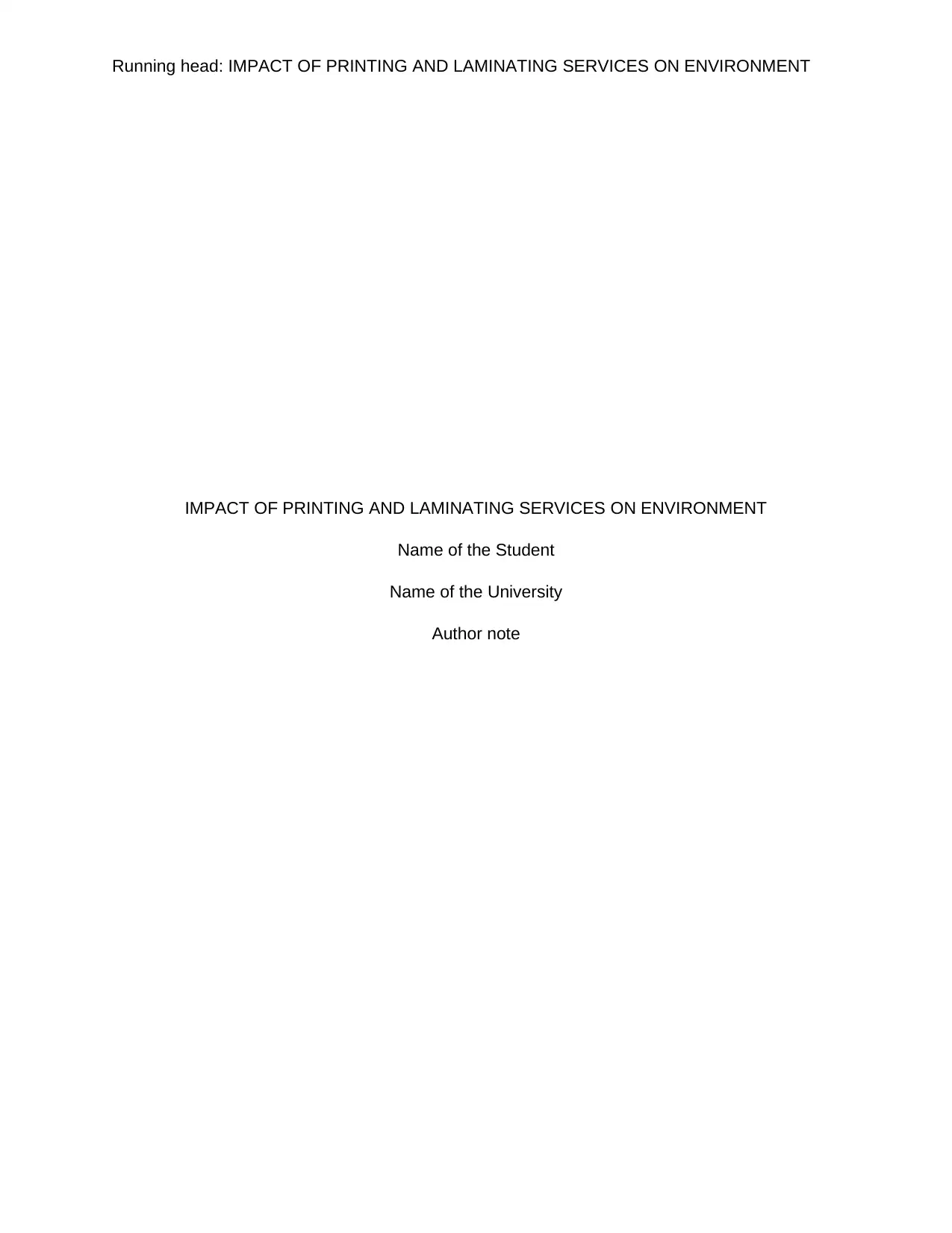
Running head: IMPACT OF PRINTING AND LAMINATING SERVICES ON ENVIRONMENT
IMPACT OF PRINTING AND LAMINATING SERVICES ON ENVIRONMENT
Name of the Student
Name of the University
Author note
IMPACT OF PRINTING AND LAMINATING SERVICES ON ENVIRONMENT
Name of the Student
Name of the University
Author note
Paraphrase This Document
Need a fresh take? Get an instant paraphrase of this document with our AI Paraphraser
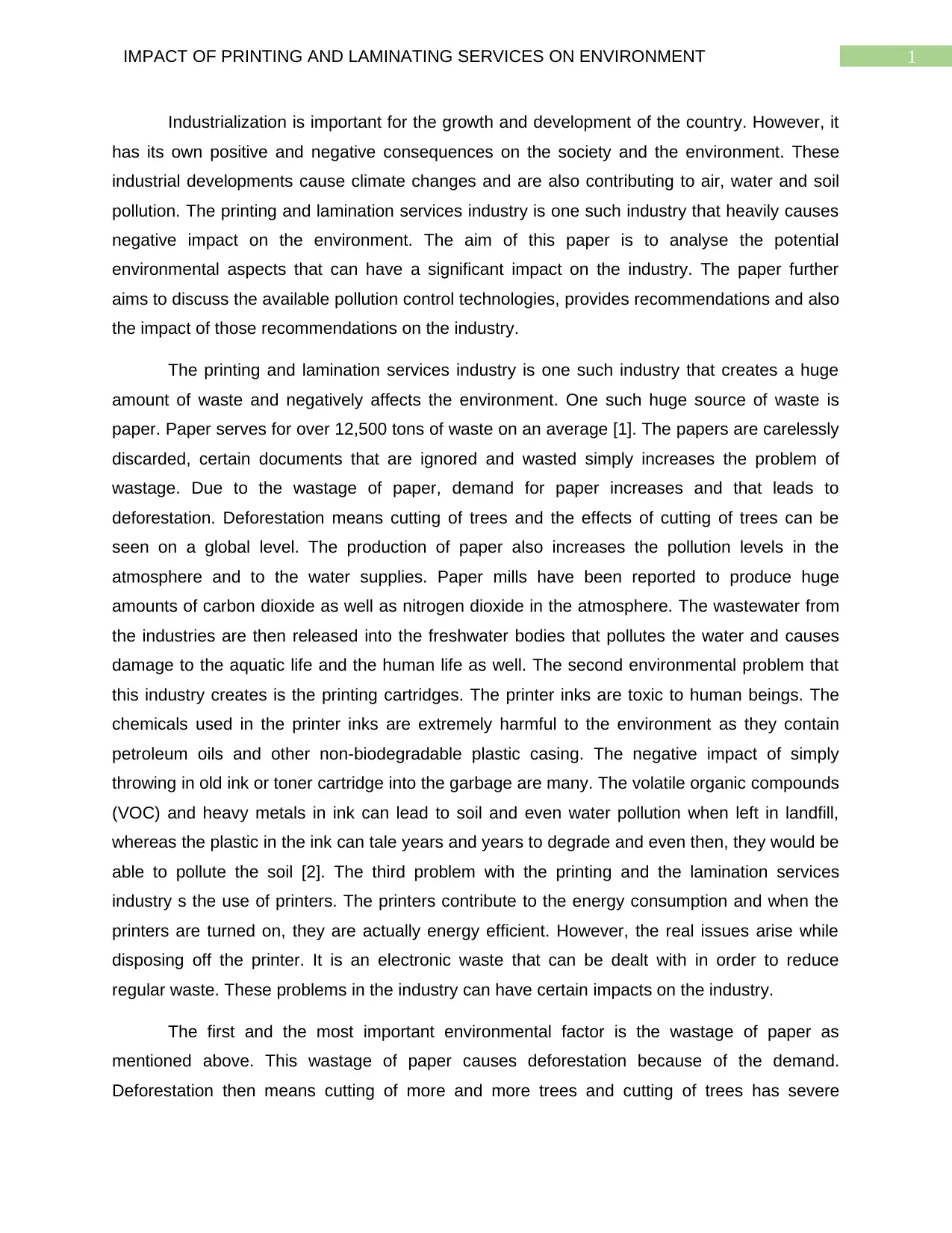
1IMPACT OF PRINTING AND LAMINATING SERVICES ON ENVIRONMENT
Industrialization is important for the growth and development of the country. However, it
has its own positive and negative consequences on the society and the environment. These
industrial developments cause climate changes and are also contributing to air, water and soil
pollution. The printing and lamination services industry is one such industry that heavily causes
negative impact on the environment. The aim of this paper is to analyse the potential
environmental aspects that can have a significant impact on the industry. The paper further
aims to discuss the available pollution control technologies, provides recommendations and also
the impact of those recommendations on the industry.
The printing and lamination services industry is one such industry that creates a huge
amount of waste and negatively affects the environment. One such huge source of waste is
paper. Paper serves for over 12,500 tons of waste on an average [1]. The papers are carelessly
discarded, certain documents that are ignored and wasted simply increases the problem of
wastage. Due to the wastage of paper, demand for paper increases and that leads to
deforestation. Deforestation means cutting of trees and the effects of cutting of trees can be
seen on a global level. The production of paper also increases the pollution levels in the
atmosphere and to the water supplies. Paper mills have been reported to produce huge
amounts of carbon dioxide as well as nitrogen dioxide in the atmosphere. The wastewater from
the industries are then released into the freshwater bodies that pollutes the water and causes
damage to the aquatic life and the human life as well. The second environmental problem that
this industry creates is the printing cartridges. The printer inks are toxic to human beings. The
chemicals used in the printer inks are extremely harmful to the environment as they contain
petroleum oils and other non-biodegradable plastic casing. The negative impact of simply
throwing in old ink or toner cartridge into the garbage are many. The volatile organic compounds
(VOC) and heavy metals in ink can lead to soil and even water pollution when left in landfill,
whereas the plastic in the ink can tale years and years to degrade and even then, they would be
able to pollute the soil [2]. The third problem with the printing and the lamination services
industry s the use of printers. The printers contribute to the energy consumption and when the
printers are turned on, they are actually energy efficient. However, the real issues arise while
disposing off the printer. It is an electronic waste that can be dealt with in order to reduce
regular waste. These problems in the industry can have certain impacts on the industry.
The first and the most important environmental factor is the wastage of paper as
mentioned above. This wastage of paper causes deforestation because of the demand.
Deforestation then means cutting of more and more trees and cutting of trees has severe
Industrialization is important for the growth and development of the country. However, it
has its own positive and negative consequences on the society and the environment. These
industrial developments cause climate changes and are also contributing to air, water and soil
pollution. The printing and lamination services industry is one such industry that heavily causes
negative impact on the environment. The aim of this paper is to analyse the potential
environmental aspects that can have a significant impact on the industry. The paper further
aims to discuss the available pollution control technologies, provides recommendations and also
the impact of those recommendations on the industry.
The printing and lamination services industry is one such industry that creates a huge
amount of waste and negatively affects the environment. One such huge source of waste is
paper. Paper serves for over 12,500 tons of waste on an average [1]. The papers are carelessly
discarded, certain documents that are ignored and wasted simply increases the problem of
wastage. Due to the wastage of paper, demand for paper increases and that leads to
deforestation. Deforestation means cutting of trees and the effects of cutting of trees can be
seen on a global level. The production of paper also increases the pollution levels in the
atmosphere and to the water supplies. Paper mills have been reported to produce huge
amounts of carbon dioxide as well as nitrogen dioxide in the atmosphere. The wastewater from
the industries are then released into the freshwater bodies that pollutes the water and causes
damage to the aquatic life and the human life as well. The second environmental problem that
this industry creates is the printing cartridges. The printer inks are toxic to human beings. The
chemicals used in the printer inks are extremely harmful to the environment as they contain
petroleum oils and other non-biodegradable plastic casing. The negative impact of simply
throwing in old ink or toner cartridge into the garbage are many. The volatile organic compounds
(VOC) and heavy metals in ink can lead to soil and even water pollution when left in landfill,
whereas the plastic in the ink can tale years and years to degrade and even then, they would be
able to pollute the soil [2]. The third problem with the printing and the lamination services
industry s the use of printers. The printers contribute to the energy consumption and when the
printers are turned on, they are actually energy efficient. However, the real issues arise while
disposing off the printer. It is an electronic waste that can be dealt with in order to reduce
regular waste. These problems in the industry can have certain impacts on the industry.
The first and the most important environmental factor is the wastage of paper as
mentioned above. This wastage of paper causes deforestation because of the demand.
Deforestation then means cutting of more and more trees and cutting of trees has severe
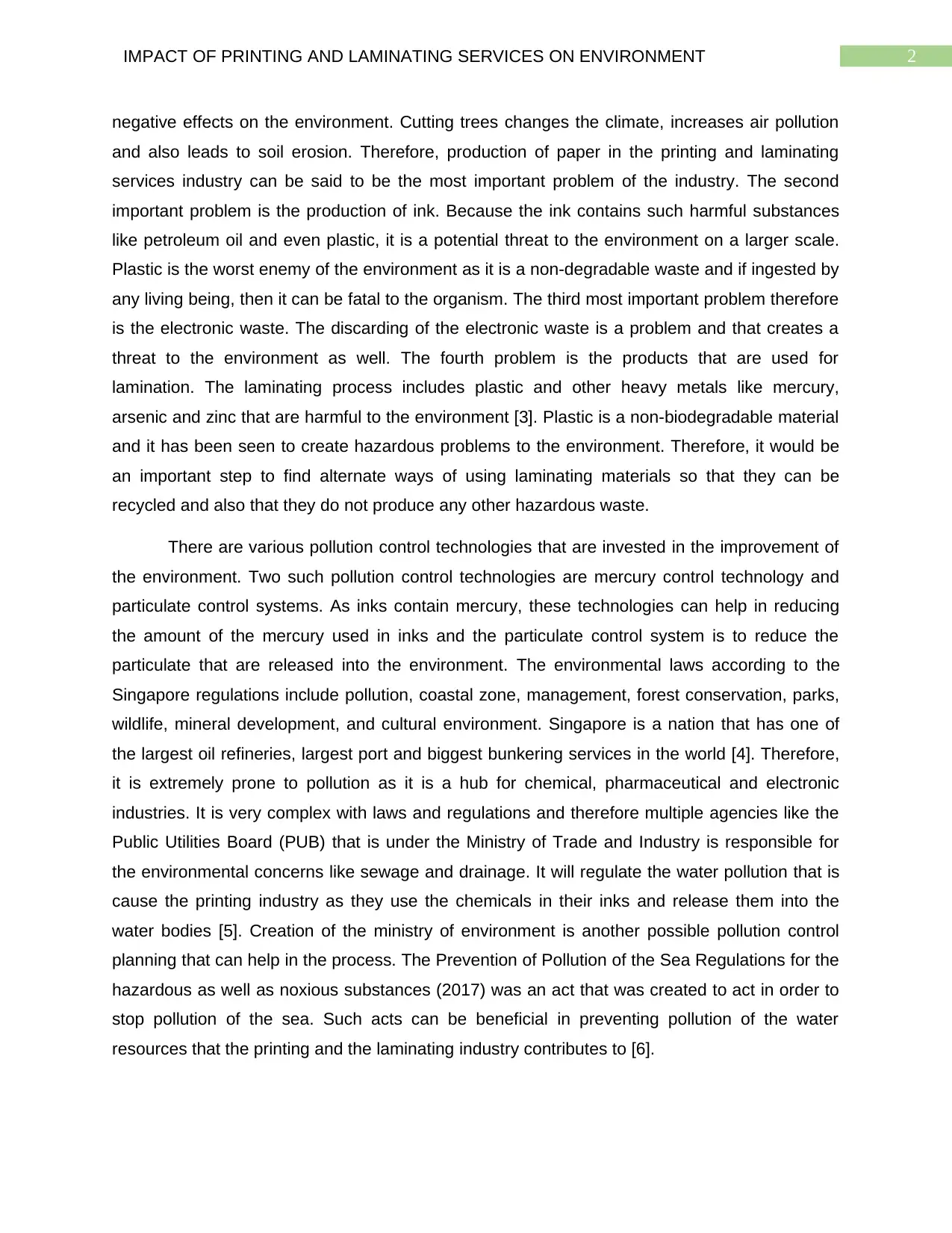
2IMPACT OF PRINTING AND LAMINATING SERVICES ON ENVIRONMENT
negative effects on the environment. Cutting trees changes the climate, increases air pollution
and also leads to soil erosion. Therefore, production of paper in the printing and laminating
services industry can be said to be the most important problem of the industry. The second
important problem is the production of ink. Because the ink contains such harmful substances
like petroleum oil and even plastic, it is a potential threat to the environment on a larger scale.
Plastic is the worst enemy of the environment as it is a non-degradable waste and if ingested by
any living being, then it can be fatal to the organism. The third most important problem therefore
is the electronic waste. The discarding of the electronic waste is a problem and that creates a
threat to the environment as well. The fourth problem is the products that are used for
lamination. The laminating process includes plastic and other heavy metals like mercury,
arsenic and zinc that are harmful to the environment [3]. Plastic is a non-biodegradable material
and it has been seen to create hazardous problems to the environment. Therefore, it would be
an important step to find alternate ways of using laminating materials so that they can be
recycled and also that they do not produce any other hazardous waste.
There are various pollution control technologies that are invested in the improvement of
the environment. Two such pollution control technologies are mercury control technology and
particulate control systems. As inks contain mercury, these technologies can help in reducing
the amount of the mercury used in inks and the particulate control system is to reduce the
particulate that are released into the environment. The environmental laws according to the
Singapore regulations include pollution, coastal zone, management, forest conservation, parks,
wildlife, mineral development, and cultural environment. Singapore is a nation that has one of
the largest oil refineries, largest port and biggest bunkering services in the world [4]. Therefore,
it is extremely prone to pollution as it is a hub for chemical, pharmaceutical and electronic
industries. It is very complex with laws and regulations and therefore multiple agencies like the
Public Utilities Board (PUB) that is under the Ministry of Trade and Industry is responsible for
the environmental concerns like sewage and drainage. It will regulate the water pollution that is
cause the printing industry as they use the chemicals in their inks and release them into the
water bodies [5]. Creation of the ministry of environment is another possible pollution control
planning that can help in the process. The Prevention of Pollution of the Sea Regulations for the
hazardous as well as noxious substances (2017) was an act that was created to act in order to
stop pollution of the sea. Such acts can be beneficial in preventing pollution of the water
resources that the printing and the laminating industry contributes to [6].
negative effects on the environment. Cutting trees changes the climate, increases air pollution
and also leads to soil erosion. Therefore, production of paper in the printing and laminating
services industry can be said to be the most important problem of the industry. The second
important problem is the production of ink. Because the ink contains such harmful substances
like petroleum oil and even plastic, it is a potential threat to the environment on a larger scale.
Plastic is the worst enemy of the environment as it is a non-degradable waste and if ingested by
any living being, then it can be fatal to the organism. The third most important problem therefore
is the electronic waste. The discarding of the electronic waste is a problem and that creates a
threat to the environment as well. The fourth problem is the products that are used for
lamination. The laminating process includes plastic and other heavy metals like mercury,
arsenic and zinc that are harmful to the environment [3]. Plastic is a non-biodegradable material
and it has been seen to create hazardous problems to the environment. Therefore, it would be
an important step to find alternate ways of using laminating materials so that they can be
recycled and also that they do not produce any other hazardous waste.
There are various pollution control technologies that are invested in the improvement of
the environment. Two such pollution control technologies are mercury control technology and
particulate control systems. As inks contain mercury, these technologies can help in reducing
the amount of the mercury used in inks and the particulate control system is to reduce the
particulate that are released into the environment. The environmental laws according to the
Singapore regulations include pollution, coastal zone, management, forest conservation, parks,
wildlife, mineral development, and cultural environment. Singapore is a nation that has one of
the largest oil refineries, largest port and biggest bunkering services in the world [4]. Therefore,
it is extremely prone to pollution as it is a hub for chemical, pharmaceutical and electronic
industries. It is very complex with laws and regulations and therefore multiple agencies like the
Public Utilities Board (PUB) that is under the Ministry of Trade and Industry is responsible for
the environmental concerns like sewage and drainage. It will regulate the water pollution that is
cause the printing industry as they use the chemicals in their inks and release them into the
water bodies [5]. Creation of the ministry of environment is another possible pollution control
planning that can help in the process. The Prevention of Pollution of the Sea Regulations for the
hazardous as well as noxious substances (2017) was an act that was created to act in order to
stop pollution of the sea. Such acts can be beneficial in preventing pollution of the water
resources that the printing and the laminating industry contributes to [6].
⊘ This is a preview!⊘
Do you want full access?
Subscribe today to unlock all pages.

Trusted by 1+ million students worldwide
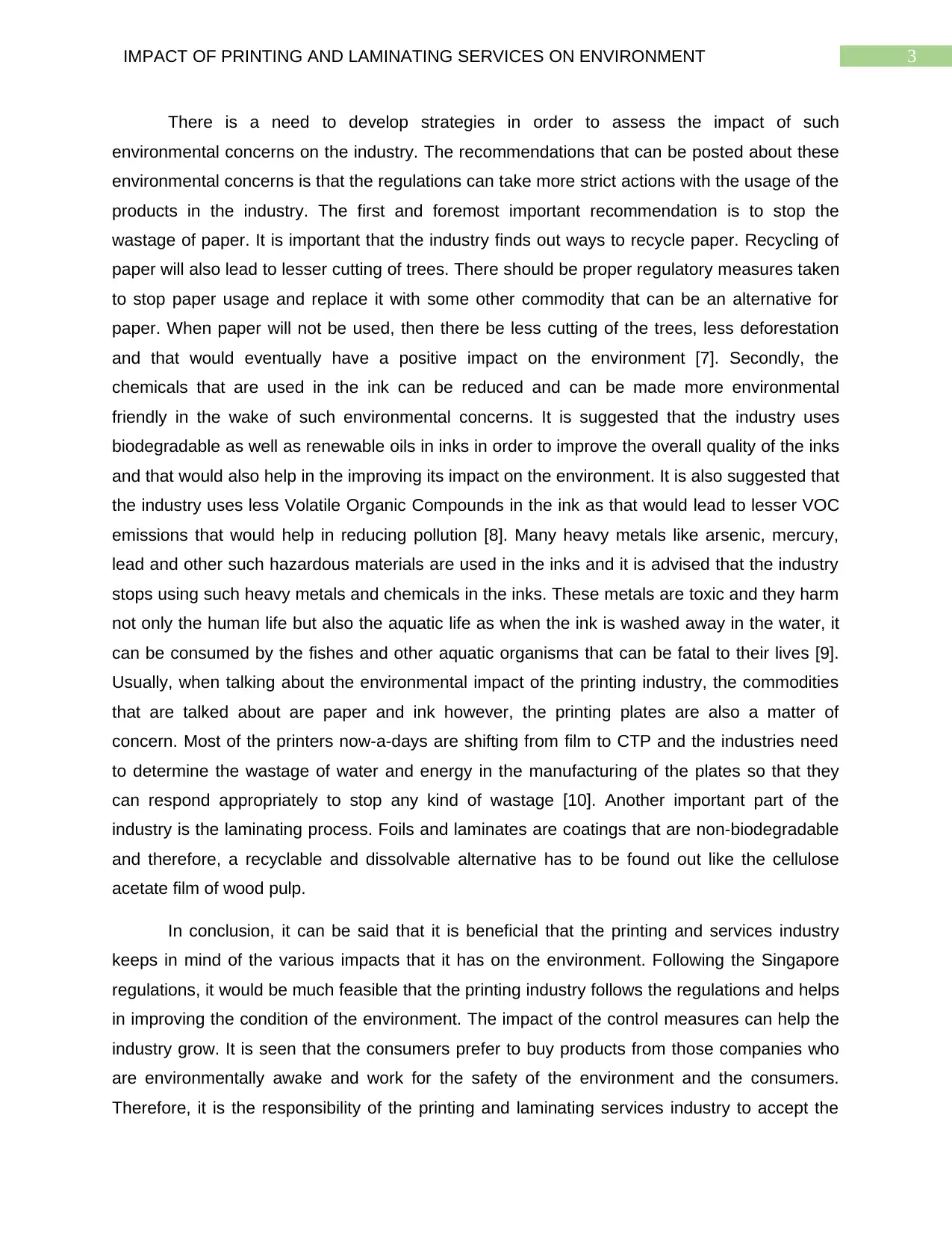
3IMPACT OF PRINTING AND LAMINATING SERVICES ON ENVIRONMENT
There is a need to develop strategies in order to assess the impact of such
environmental concerns on the industry. The recommendations that can be posted about these
environmental concerns is that the regulations can take more strict actions with the usage of the
products in the industry. The first and foremost important recommendation is to stop the
wastage of paper. It is important that the industry finds out ways to recycle paper. Recycling of
paper will also lead to lesser cutting of trees. There should be proper regulatory measures taken
to stop paper usage and replace it with some other commodity that can be an alternative for
paper. When paper will not be used, then there be less cutting of the trees, less deforestation
and that would eventually have a positive impact on the environment [7]. Secondly, the
chemicals that are used in the ink can be reduced and can be made more environmental
friendly in the wake of such environmental concerns. It is suggested that the industry uses
biodegradable as well as renewable oils in inks in order to improve the overall quality of the inks
and that would also help in the improving its impact on the environment. It is also suggested that
the industry uses less Volatile Organic Compounds in the ink as that would lead to lesser VOC
emissions that would help in reducing pollution [8]. Many heavy metals like arsenic, mercury,
lead and other such hazardous materials are used in the inks and it is advised that the industry
stops using such heavy metals and chemicals in the inks. These metals are toxic and they harm
not only the human life but also the aquatic life as when the ink is washed away in the water, it
can be consumed by the fishes and other aquatic organisms that can be fatal to their lives [9].
Usually, when talking about the environmental impact of the printing industry, the commodities
that are talked about are paper and ink however, the printing plates are also a matter of
concern. Most of the printers now-a-days are shifting from film to CTP and the industries need
to determine the wastage of water and energy in the manufacturing of the plates so that they
can respond appropriately to stop any kind of wastage [10]. Another important part of the
industry is the laminating process. Foils and laminates are coatings that are non-biodegradable
and therefore, a recyclable and dissolvable alternative has to be found out like the cellulose
acetate film of wood pulp.
In conclusion, it can be said that it is beneficial that the printing and services industry
keeps in mind of the various impacts that it has on the environment. Following the Singapore
regulations, it would be much feasible that the printing industry follows the regulations and helps
in improving the condition of the environment. The impact of the control measures can help the
industry grow. It is seen that the consumers prefer to buy products from those companies who
are environmentally awake and work for the safety of the environment and the consumers.
Therefore, it is the responsibility of the printing and laminating services industry to accept the
There is a need to develop strategies in order to assess the impact of such
environmental concerns on the industry. The recommendations that can be posted about these
environmental concerns is that the regulations can take more strict actions with the usage of the
products in the industry. The first and foremost important recommendation is to stop the
wastage of paper. It is important that the industry finds out ways to recycle paper. Recycling of
paper will also lead to lesser cutting of trees. There should be proper regulatory measures taken
to stop paper usage and replace it with some other commodity that can be an alternative for
paper. When paper will not be used, then there be less cutting of the trees, less deforestation
and that would eventually have a positive impact on the environment [7]. Secondly, the
chemicals that are used in the ink can be reduced and can be made more environmental
friendly in the wake of such environmental concerns. It is suggested that the industry uses
biodegradable as well as renewable oils in inks in order to improve the overall quality of the inks
and that would also help in the improving its impact on the environment. It is also suggested that
the industry uses less Volatile Organic Compounds in the ink as that would lead to lesser VOC
emissions that would help in reducing pollution [8]. Many heavy metals like arsenic, mercury,
lead and other such hazardous materials are used in the inks and it is advised that the industry
stops using such heavy metals and chemicals in the inks. These metals are toxic and they harm
not only the human life but also the aquatic life as when the ink is washed away in the water, it
can be consumed by the fishes and other aquatic organisms that can be fatal to their lives [9].
Usually, when talking about the environmental impact of the printing industry, the commodities
that are talked about are paper and ink however, the printing plates are also a matter of
concern. Most of the printers now-a-days are shifting from film to CTP and the industries need
to determine the wastage of water and energy in the manufacturing of the plates so that they
can respond appropriately to stop any kind of wastage [10]. Another important part of the
industry is the laminating process. Foils and laminates are coatings that are non-biodegradable
and therefore, a recyclable and dissolvable alternative has to be found out like the cellulose
acetate film of wood pulp.
In conclusion, it can be said that it is beneficial that the printing and services industry
keeps in mind of the various impacts that it has on the environment. Following the Singapore
regulations, it would be much feasible that the printing industry follows the regulations and helps
in improving the condition of the environment. The impact of the control measures can help the
industry grow. It is seen that the consumers prefer to buy products from those companies who
are environmentally awake and work for the safety of the environment and the consumers.
Therefore, it is the responsibility of the printing and laminating services industry to accept the
Paraphrase This Document
Need a fresh take? Get an instant paraphrase of this document with our AI Paraphraser

4IMPACT OF PRINTING AND LAMINATING SERVICES ON ENVIRONMENT
environmental friendly ways of working and acknowledge the fact that it is extremely important
to care about the environment as care for all living beings on the planet.
environmental friendly ways of working and acknowledge the fact that it is extremely important
to care about the environment as care for all living beings on the planet.
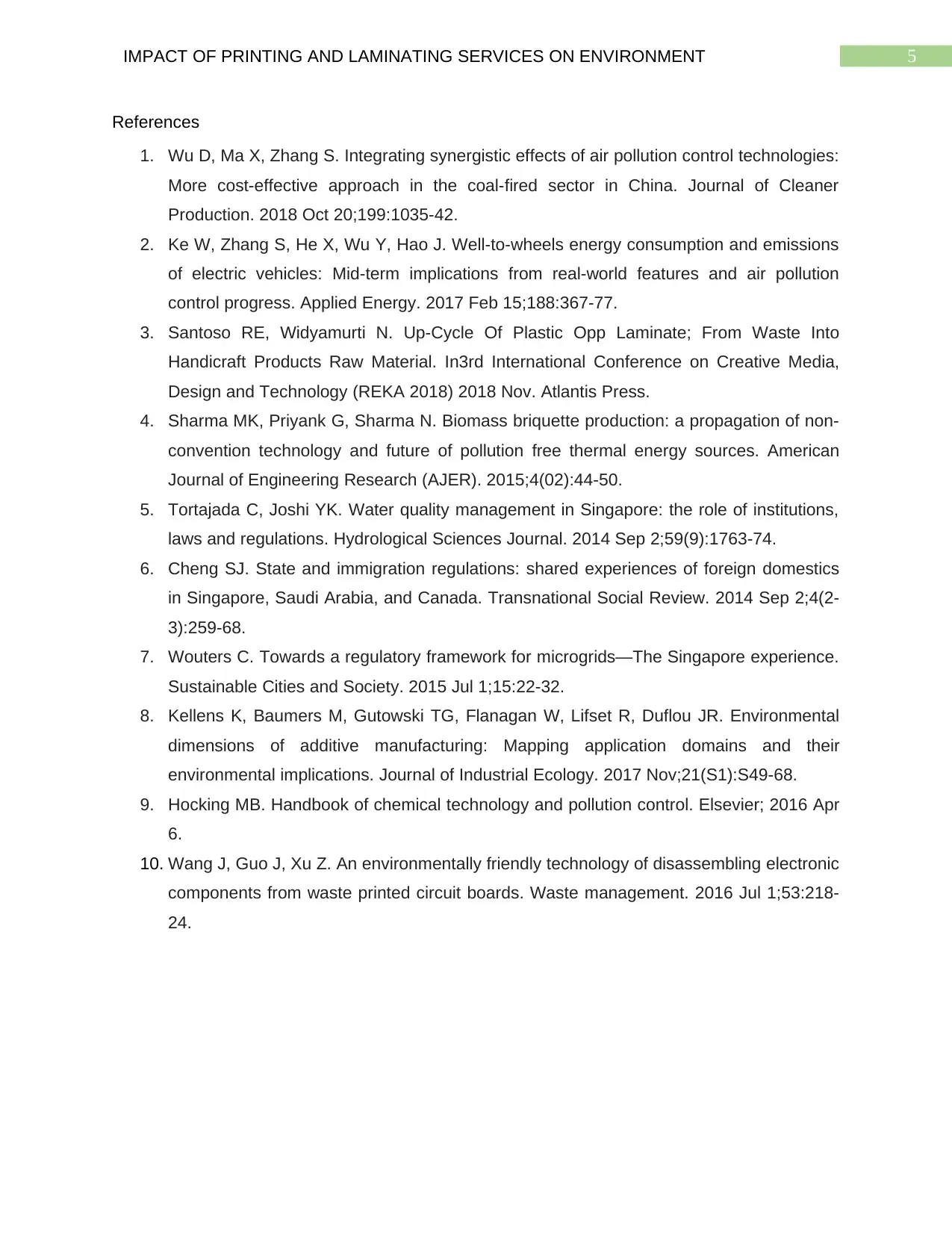
5IMPACT OF PRINTING AND LAMINATING SERVICES ON ENVIRONMENT
References
1. Wu D, Ma X, Zhang S. Integrating synergistic effects of air pollution control technologies:
More cost-effective approach in the coal-fired sector in China. Journal of Cleaner
Production. 2018 Oct 20;199:1035-42.
2. Ke W, Zhang S, He X, Wu Y, Hao J. Well-to-wheels energy consumption and emissions
of electric vehicles: Mid-term implications from real-world features and air pollution
control progress. Applied Energy. 2017 Feb 15;188:367-77.
3. Santoso RE, Widyamurti N. Up-Cycle Of Plastic Opp Laminate; From Waste Into
Handicraft Products Raw Material. In3rd International Conference on Creative Media,
Design and Technology (REKA 2018) 2018 Nov. Atlantis Press.
4. Sharma MK, Priyank G, Sharma N. Biomass briquette production: a propagation of non-
convention technology and future of pollution free thermal energy sources. American
Journal of Engineering Research (AJER). 2015;4(02):44-50.
5. Tortajada C, Joshi YK. Water quality management in Singapore: the role of institutions,
laws and regulations. Hydrological Sciences Journal. 2014 Sep 2;59(9):1763-74.
6. Cheng SJ. State and immigration regulations: shared experiences of foreign domestics
in Singapore, Saudi Arabia, and Canada. Transnational Social Review. 2014 Sep 2;4(2-
3):259-68.
7. Wouters C. Towards a regulatory framework for microgrids—The Singapore experience.
Sustainable Cities and Society. 2015 Jul 1;15:22-32.
8. Kellens K, Baumers M, Gutowski TG, Flanagan W, Lifset R, Duflou JR. Environmental
dimensions of additive manufacturing: Mapping application domains and their
environmental implications. Journal of Industrial Ecology. 2017 Nov;21(S1):S49-68.
9. Hocking MB. Handbook of chemical technology and pollution control. Elsevier; 2016 Apr
6.
10. Wang J, Guo J, Xu Z. An environmentally friendly technology of disassembling electronic
components from waste printed circuit boards. Waste management. 2016 Jul 1;53:218-
24.
References
1. Wu D, Ma X, Zhang S. Integrating synergistic effects of air pollution control technologies:
More cost-effective approach in the coal-fired sector in China. Journal of Cleaner
Production. 2018 Oct 20;199:1035-42.
2. Ke W, Zhang S, He X, Wu Y, Hao J. Well-to-wheels energy consumption and emissions
of electric vehicles: Mid-term implications from real-world features and air pollution
control progress. Applied Energy. 2017 Feb 15;188:367-77.
3. Santoso RE, Widyamurti N. Up-Cycle Of Plastic Opp Laminate; From Waste Into
Handicraft Products Raw Material. In3rd International Conference on Creative Media,
Design and Technology (REKA 2018) 2018 Nov. Atlantis Press.
4. Sharma MK, Priyank G, Sharma N. Biomass briquette production: a propagation of non-
convention technology and future of pollution free thermal energy sources. American
Journal of Engineering Research (AJER). 2015;4(02):44-50.
5. Tortajada C, Joshi YK. Water quality management in Singapore: the role of institutions,
laws and regulations. Hydrological Sciences Journal. 2014 Sep 2;59(9):1763-74.
6. Cheng SJ. State and immigration regulations: shared experiences of foreign domestics
in Singapore, Saudi Arabia, and Canada. Transnational Social Review. 2014 Sep 2;4(2-
3):259-68.
7. Wouters C. Towards a regulatory framework for microgrids—The Singapore experience.
Sustainable Cities and Society. 2015 Jul 1;15:22-32.
8. Kellens K, Baumers M, Gutowski TG, Flanagan W, Lifset R, Duflou JR. Environmental
dimensions of additive manufacturing: Mapping application domains and their
environmental implications. Journal of Industrial Ecology. 2017 Nov;21(S1):S49-68.
9. Hocking MB. Handbook of chemical technology and pollution control. Elsevier; 2016 Apr
6.
10. Wang J, Guo J, Xu Z. An environmentally friendly technology of disassembling electronic
components from waste printed circuit boards. Waste management. 2016 Jul 1;53:218-
24.
⊘ This is a preview!⊘
Do you want full access?
Subscribe today to unlock all pages.

Trusted by 1+ million students worldwide
1 out of 6
Related Documents
Your All-in-One AI-Powered Toolkit for Academic Success.
+13062052269
info@desklib.com
Available 24*7 on WhatsApp / Email
![[object Object]](/_next/static/media/star-bottom.7253800d.svg)
Unlock your academic potential
Copyright © 2020–2025 A2Z Services. All Rights Reserved. Developed and managed by ZUCOL.




